Key Points
- Encounters with most of these dangerous flying animals in Virginia will not result in death for humans.
- The biggest risk from the majority of these dangerous flying animals is contraction of a deadly disease.
- Most of the animals on this list only attack if provoked or threatened.
Virginia is a state that is rich in culture and in beauty. Five separate ecological regions make up Virginia, with a variety of wildlife in each region. Known as the “birthplace of a nation” Virginia was the first location of permanent English settlement. In addition to its historical significance, Virginia also holds significance in regard to wildlife. Virginia is home to 41 state parks and 22 national parks, providing lots of space for people to enjoy the wildlife and nature that this state has to offer.

This reservoir is named for locally born Thomas Stonewall Jackson, a Confederate general during the American Civil War.
©Malachi Jacobs/Shutterstock.com
Is Virginia Dangerous?
Virginia is home to a variety of dangerous animals. Many of them are well-known, such as the eastern copperhead and black bear, but many of them fly under the radar. When thinking about the most dangerous animals, people often focus on the largest animals or the ones that they would find closest to their homes. Have you ever wondered about the creatures flying above you? Danger lurks in more than just the tall grasses and forests! This article will cover the top eight dangerous animals flying in Virginia’s skies.
List of Most Dangerous Flying Animals in Virginia
Below is a list of the top eight most dangerous flying animals in Virginia’s skies ranked in order of most dangerous to least dangerous.
1. Mosquitos (Culicidae)
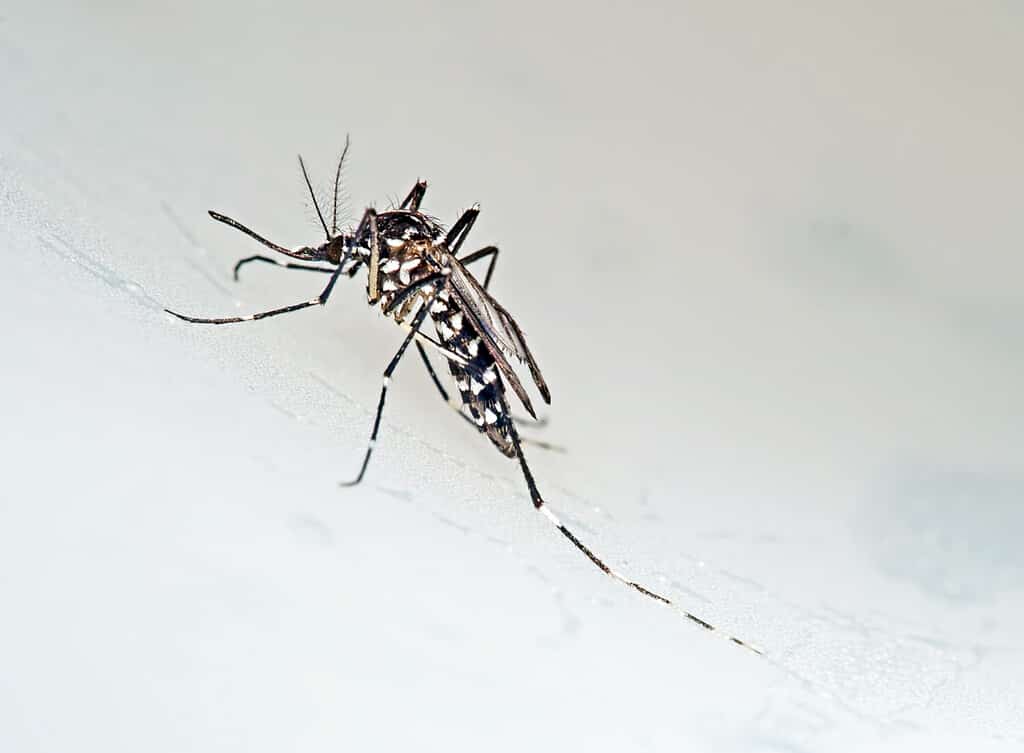
Although small, mosquitos are dangerous flying animals due to their ability to easily spread disease.
©Sarah2/Shutterstock.com
These pesky insects can be found buzzing all over the United States and Virginia is no exception. In Virginia, if you are bitten by a mosquito during the day, there is a 90 percent chance that it is an Asian tiger mosquito. Although these mosquitoes are native to subtropical areas of Southeast Asia, they have made their way over to the east coast of the United States. The white striping along their bodies makes these mosquitos easy to distinguish.
Besides leaving behind annoying and itchy bumps, these insects cause a potential threat to human health. The West Nile virus is the most common disease that is spread by these mosquitos. Other mosquito-borne illnesses in the area include the La Crosse encephalitis virus, the St. Louis encephalitis virus, and the eastern equine encephalitis virus. Although serious illness is rare, people can develop severe, life-threatening symptoms. For those who do develop serious illness from these viruses, about 10 percent of them result in death. This mosquito is a stealthy yet aggressive biter. It will mainly focus on biting feet, ankles, and the underside of arms, where it is less easily detected. This mosquito also poses a risk to domesticated animals, such as horses and dogs, as its prey varies and it can cause debilitating diseases in all.
2. Kissing Bugs (Triatominae)
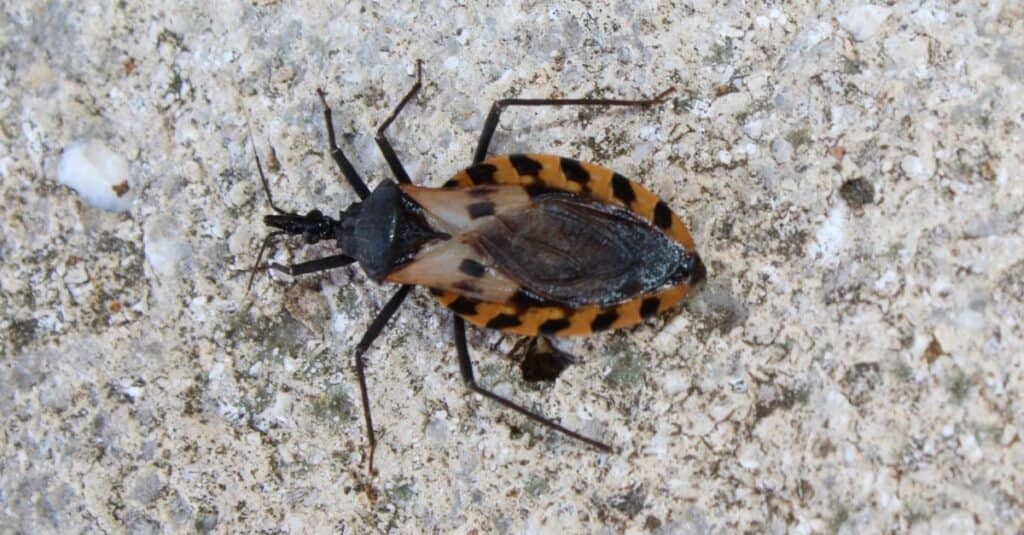
Assassin bugs or “kissing bugs” get their names from their habit of biting humans on the face near the lips while they sleep. Only adult kissing bugs have wings.
©Vanessa Becker-Miller/Shutterstock.com
Despite their cute name, kissing bugs are far from something adorable to look at. These insects are large and dark brown, usually ranging from 0.5 to over an inch in length. These bugs get their name because they generally bite people while they sleep and they favor the area around a person’s face or mouth. Kissing bugs are similar to bedbugs in the fact that they drink blood as their food source.
Although the adolescent kissing bugs do not have wings, the adult kissing bugs do. They use their wings to fly to their prey, just as easily as they can crawl to them. They are often found in outdoor habitats of domesticated animals, such as dog-bedding in a dog house or in a chicken coop. The reason that these insects are so dangerous is because they carry the potential of the Chagas disease. According to the Virginia Department of Health, “It is caused by the parasite Trypanosoma cruzi, which is transmitted to animals and people by ‘kissing bugs’ and is found only in the Americas.” The disease is spread when the kissing bug bites and then defecates on the person. The feces spreads into the wound and the infection begins.
While the majority of cases of Chagas disease will be mild, there are cases where the acute infection can lead to inflammation of the heart, brain, and lining of the brain. Scientists believe that there are at least 300,000 cases of Chagas disease in the United States today.
3. Bats (Chiroptera)

Predominately nocturnal creatures, people only need to worry about this dangerous flying animal at night.
©Jay Ondreicka/Shutterstock.com
Out of the 1,300 total bat species, 47 of them live in the United States. Out of that 47, 17 species of bat have been recorded in Virginia. Most of the time, bats do not bother humans. As nocturnal hunters, many people do not often encounter bats. They also act as important pollinators and their diet consists of various insects, some of which — like the mosquito — can cause harm to humans. A colony of bats can consume 500,000 pounds of bugs in one night! Three species of bat — gray, Indiana, and Virginia big-eared bats — are considered endangered in Virginia.
The reason that these seemingly harmless animals make it on Virginia’s most dangerous flying animals list is because of their possibility of rabies infection. Although it is uncommon for bats to attack humans, they are the leading cause of rabies deaths in people in the United States. While bats are one of the most commonly reported animals with rabies, there is one species that stands out among the rest. The silver-haired bat is a main candidate for rabies research because it carries a species-specific form of rabies that is known to infect humans. Although less than five percent of bats collected for testing belonged to the silver-haired bat species, they are most commonly found in the northeastern United States and they are the most likely to interact with humans.
You can identify these bats by the silver tips that cover their black fur. They are also most commonly found in the summer months, therefore that is the time to be most vigilant.
4. Bald-Faced Hornet (Dolichovespula maculata)
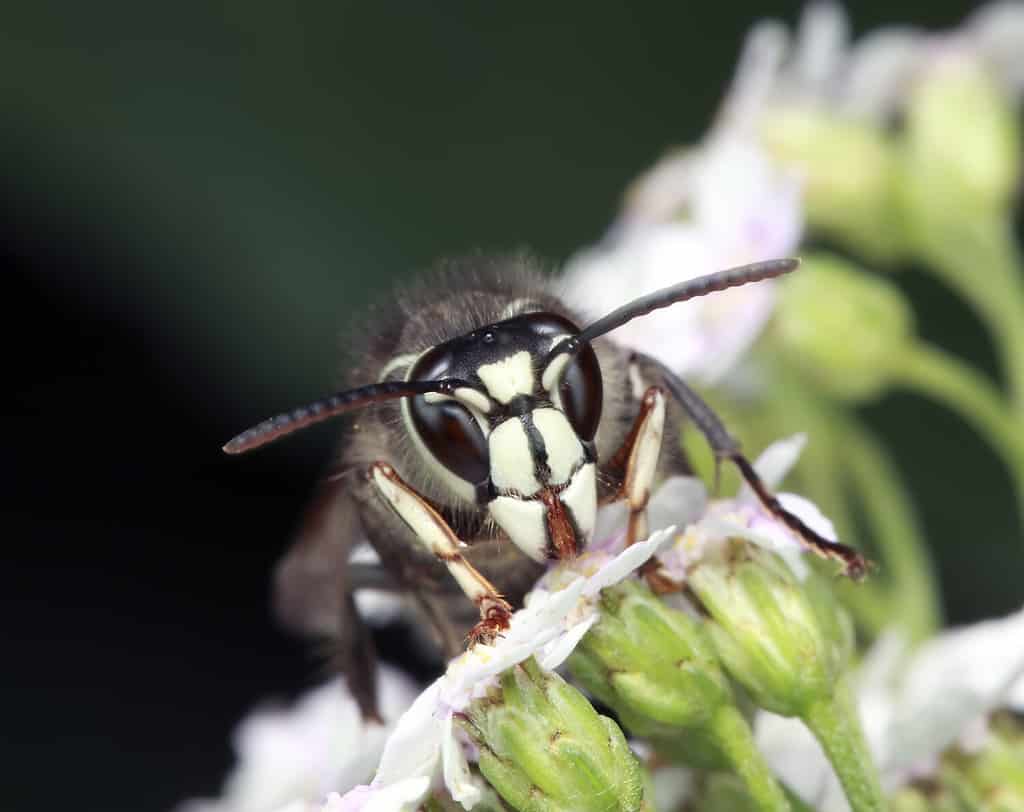
Often mistaken for yellowjackets, this insect can be distinguished by its white and black coloring versus the typical yellow and black hues.
©5D2/Shutterstock.com
Contrary to their name, these insects are not actually hornets. Instead, they are a part of the yellowjacket family. These insects are black and white and get their hornet name because of their size and aggressive nature. Similarly to other wasps and hornets, these insects can sting multiple times. If someone is allergic, the sting of a bald-faced hornet can be life-threatening. Even for those who are not allergic, the sting will cause great discomfort. The sting of a bald-faced hornet carries a venom that will cause pain, swelling, and itching for at least 24 hours.
What makes these insects more dangerous than others is their heightened sense of aggression. These insects are extremely territorial, and unlike other insects, they will attack more readily. They are very sensitive creatures — particularly to external noises or vibrations — and will attack if you get anywhere near their space.
A way to avoid these insects is to look for their nests. Hanging from trees or underneath overhangs, their nests resemble paper. The bald-faced hornet is most active during the day as it is constructing its nest, so it is best to avoid it at this time.
5. Bald Eagle (Haliaeetus leucocephalus)
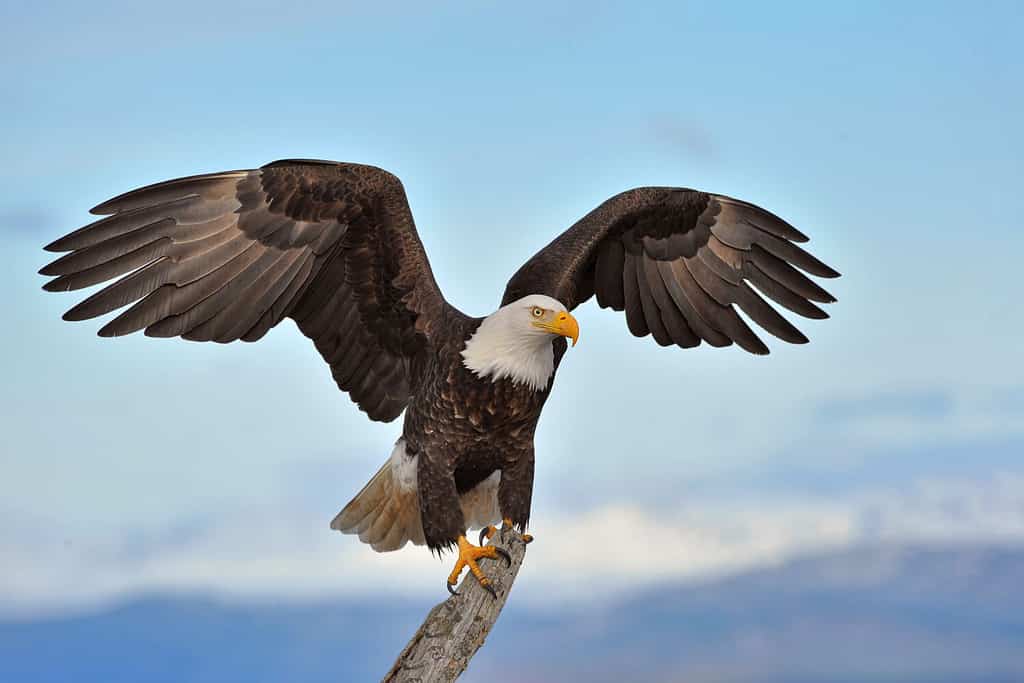
The bald eagle population is making a large comeback in Virginia. There are currently 1,100 pairs!
©FloridaStock/Shutterstock.com
As our national bird, the bald eagle is a very well-known bird. What is less well-known, however, is the danger that it can pose to humans. The bald eagle is one of the largest birds — ranging from 28-38 inches in length — with a wingspan of up to seven feet! These birds weigh between 6 and 14 pounds and they can easily carry up to 5 pounds. They have impressively sharp beaks and talons that they use to hunt and defend themselves.
Bald eagles can exert more than 400 pounds of force per square inch with their razor-sharp talons. In addition, the grip of a bald eagle is 10 times stronger than that of an adult human grip. This is definitely not an animal you would want to upset. While attacks on humans are very rare, these eagles are extremely protective of their nests and would attack if provoked.
Death is highly unlikely; however, if the eagle manages to score a direct hit with its sharp talons on one of the major arteries or veins in the neck, a person could die.
6. Great Horned Owl (Bubo virginianus)
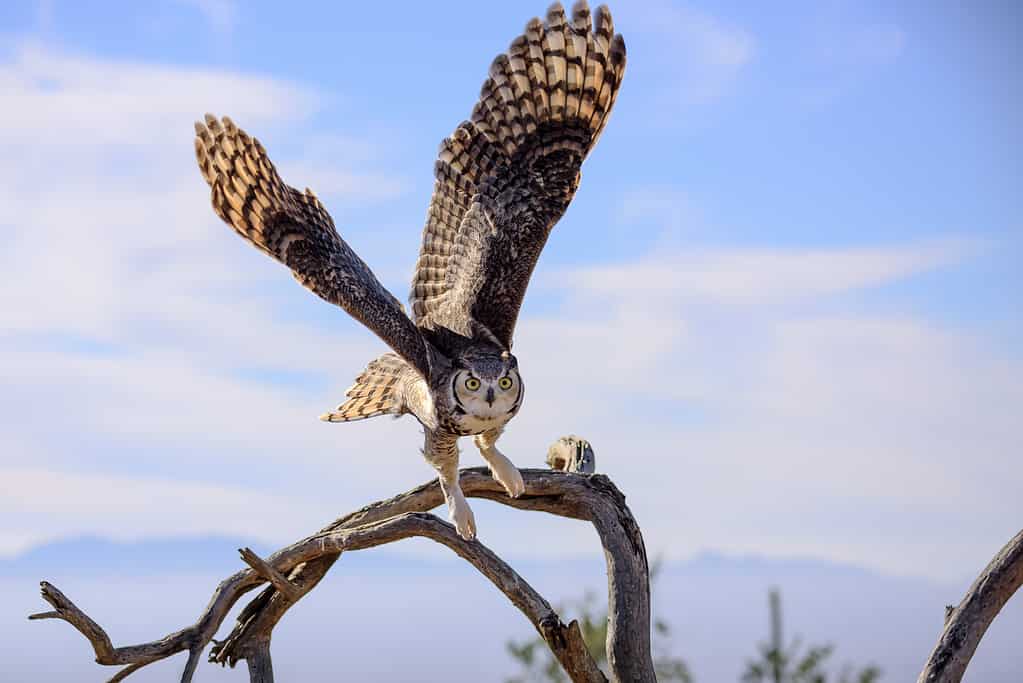
The great horned owl has the largest wingspan of any North American owl.
©iStock.com/kojihirano
The great horned owl is often what comes to mind when told to picture an owl. Their large, yellow eyes and wise-looking expressions make them the owls often represented in storybooks. However, their dangerous capabilities — unlike their physical appearance — are not often represented. These owls average about 22 inches in length, and their wingspan can reach up to five feet.
Although great horned owls usually only reach up to five pounds, they have great strength. Due to their abilities to successfully hunt a variety of prey, they have been referred to as “the tigers of the sky.” They feed on smaller mammals, such as rodents or rabbits, but can also feast on larger animals such as skunks, geese, and porcupines. Great horned owls are able to feast on these larger prey because of their impressive talons. Their talons require a force of 28 pounds to be opened. When they grasp a prey in their powerful talons, the spine of their prey is quickly severed.
While attacks on humans are rare, they do happen. Great horned owls prefer the undisturbed habitats of forests, but they can be found in a variety of more semi-open locations. They will attack if they feel their nest is threatened. While no one has died from a great horned owl attack, these animals are dangerous because they have caused people serious injuries.
7. Peregrine Falcons (Falco peregrinus)
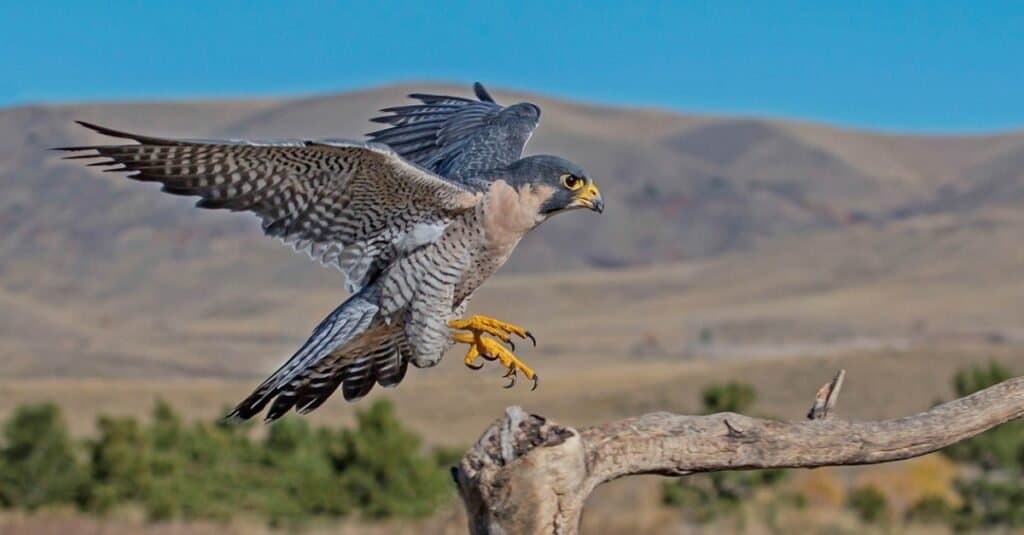
Peregrine falcon
s are known for their high-speed dives! They are the fastest animals in the world.
©iStock.com/DawnKey
Peregrine falcons are the fastest-moving animal in the world. They can dive at a speed of up to 240 miles per hour. Peregrine falcons do these impressive dives to obtain their prey. Their prey includes shorebirds, pigeons, and other medium-sized birds. Their sharp talons allow them to easily strike and then grasp their prey. They are capable of attacking prey on the ground and in the air.
While attacks on humans are rare, the peregrine falcon’s sharp talons and beak do allow it to cause serious harm to a person. Usually, these falcons are not considered dangerous and will only attack if they feel that their nest is threatened. Close contact with these animals should be avoided.
8. Red-Tailed Hawk (Falco jamaicensis)
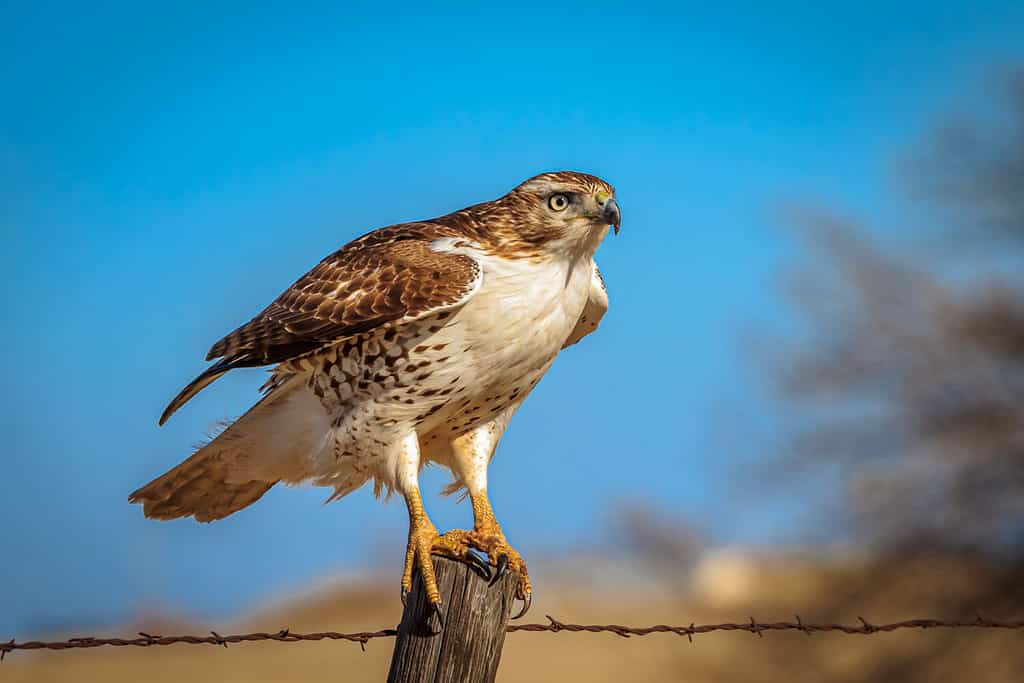
Red-tailed hawks inhabit North America. While not usually considered dangerous animals, they are exceptional hunters that could pose a threat to humans if provoked.
©Richard G Smith/Shutterstock.com
Out of the six species of hawk that reside in Virginia, the red-tailed hawk is probably the most well-known. Red-tailed hawks are a fairly common sight, both soaring through the skies and resting on telephone poles. The red-tailed hawk will thrive as long as it has open ground for hunting and places to perch high up, even though its habitat varies. Their diet is strongly varied, ranging from mammals, like moles, to birds, such as pheasants. Snakes, frogs, squirrels, and insects are other creatures that the red-tailed hawk eats as well.
These birds make it on the most dangerous flying animals in Virginia list due to their particularly aggressive behavior during mating season. Like many other animals, if the red-tailed hawk feels threatened or provoked they will attack. With a ripping force of nearly 200 pounds per square inch, this is not a bird that you want to upset. While deaths from these attacks are uncommon, serious injuries can occur.
Summary of Most Dangerous Flying Animals in Virginia
Below is a summary of the most dangerous animals flying in Virginia’s skies, as well as a description of the threat that they pose to humans.
| Danger Rank | Animal | Scientific Name | Threat They Pose |
|---|---|---|---|
| 1 | Mosquito | Culicidae | Very common and can carry diseases such as the West Nile Virus. |
| 2 | Kissing bug | Triatominae | Often found in domesticated animal outdoor habitats, can carry Chagas disease. |
| 3 | Bat | Chiroptera | Attacks not common, but leading cause of rabies in humans. |
| 4 | Bald-faced hornet | Dolichovespula maculata | Very common, only deadly if allergic but can cause serious pain and swelling. |
| 5 | Bald eagle | Haliaeetus leucocephalus | Very large bird that can cause harm with sharp talons and beak. |
| 6 | Great horned owl | Bubo virginianus | Talons require a force of 28 pounds to be opened, can cause serious injuries. |
| 7 | Peregrine falcon | Falco peregrinus | Capable of attacking prey both on the ground and in the air. Will attack if nest is threatened. |
| 8 | Red-tailed hawk | Falco jamaicensis | Particularly aggressive during mating season. |
The photo featured at the top of this post is © ranchorunner/Shutterstock.com
Thank you for reading! Have some feedback for us? Contact the AZ Animals editorial team.







